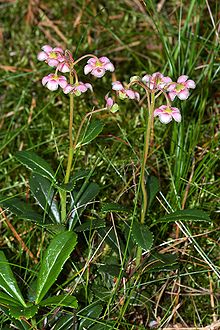Chimaphila umbellata
| Chimaphila umbellata | |
|---|---|
 |
|
| Scientific classification | |
| Kingdom: | Plantae |
| (unranked): | Angiosperms |
| (unranked): | Eudicots |
| (unranked): | Asterids |
| Order: | Ericales |
| Family: | Ericaceae |
| Genus: | Chimaphila |
| Species: | C. umbellata |
| Binomial name | |
|
Chimaphila umbellata (L.) Barton |
|
Chimaphila umbellata (Umbellate Wintergreen, Pipsissewa, or Prince's pine) is a small perennial flowering plant found in dry woodlands, or sandy soils. It is native throughout the cool temperate Northern Hemisphere.
It grows 10–35 cm tall, and has evergreen shiny, bright green, toothed leaves arranged in opposite pairs or whorls of 3-4 along the stem. Leaves have a shallowly toothed margin, where the teeth have fine hairs at their ends. The flowers are white or pink, produced in a small umbel of 4-8 together.
Although it has green leaves year-round, it receives a significant portion of its nutrition from fungi in the soil (that is, it is a partial myco-heterotroph, which is not surprising as related plants, such as Pyrola, are partial or full myco-heterotrophs).
There are four subspecies:
Some Plateau Indian tribes used a boil of prince's pine to treat tuberculosis.
It is used as a flavoring in candy and soft drinks, particularly root beer.
"Pipsissewa" is a Cree name meaning "It-breaks-into-small-pieces".
...
Wikipedia

